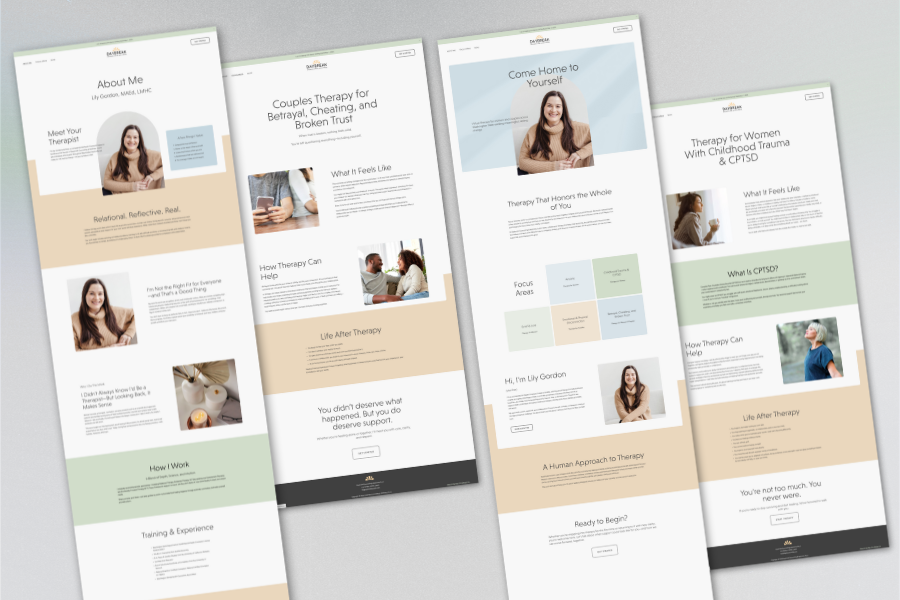After You Choose Your Niche: Mastering Your Message
Quick Answer for Skimmers (and Search Engines):
After choosing a therapy niche, the next step is learning how to communicate it clearly. This article helps therapists master their messaging by refining tone, using client-centered language, and writing in a way that feels genuine and human. It explains how to avoid therapist jargon, name pain points compassionately, balance expertise with warmth, and weave personal values subtly through phrasing and rhythm. The goal is to help therapists write website and marketing copy that sounds like them: grounded, clear, and aligned with how therapy with them actually feels.
In part one, we explored how to choose a niche that feels aligned and sustainable.
You can read that here: How to Know Your Niche Fits You (Without Overthinking It)
In this piece, we’ll look at what happens next; how to speak directly to your niche through your writing and messaging so that the people you most want to work with can recognize themselves in your words.
After You Choose Your Niche: Mastering Your Message
Speaking Directly to Your Niche
Choosing a niche is only the first step. The next challenge is learning how to talk about it.
Therapists often freeze at this stage. They know who they want to reach, but when they sit down to write, everything sounds either too academic, too vague, or too similar to everyone else. They start to wonder if they even have a clear voice at all.
In my experience, therapists DO have a voice. You use it every day in session. The task now is to translate that voice into writing, so that your words on a screen sound like the grounded, compassionate, curious person you are.
Let’s walk through how to do that.
1. Find Your Tone
Tone communicates more than any marketing line ever could. It tells a potential client what it might feel like to sit across from you.
Is your tone calm and steady, or warm and conversational? Do you want clients to feel soothed and safe, or gently activated and inspired? Neither is better; what matters is that the tone reflects you and the emotional atmosphere of your work.
If you’re not sure where to start, try this: imagine the energy of your favorite therapy sessions. How do you sound there? Are you measured, gentle, direct, playful, grounded? Write a few sentences in that tone. Then read them out loud. If it sounds like something you would actually say, you’re on the right track.
Tone is an extension of your clinical presence. It’s how you begin to build trust before a client ever contacts you.
2. Speak Their Language, Not Yours
Therapists often describe what they do instead of what clients feel.
We might write, “I help clients develop insight and emotional regulation skills.” But what our clients might say is, “I’m tired of feeling like my emotions take over everything.”
When you write, imagine your client trying to describe their struggle to a friend. What words would they use? Your job is to meet them in that language. Not to oversimplify your expertise, but to make it understandable and relatable.
Instead of “attachment wounds,” say “feeling stuck in the same painful relationship patterns.” Instead of “values-based behavioral activation,” say “reconnecting with the parts of life that make you feel alive.”
When clients hear themselves in your words, they begin to trust you long before the first session.
3. Avoid Jargon and Over-Explaining
One of the hardest habits to break is writing like a clinician instead of a human.
Jargon creates distance. It makes clients feel like they’re reading a textbook about therapy, not an invitation into it.
Ask yourself:
Does this sentence sound like something I’d actually say in a session?
Am I explaining too much to prove my expertise?
Would a potential client need a psychology degree to understand this paragraph?
When in doubt, strip it back. Say less. Use words that are familiar.
You don’t need to prove that you know what you’re doing. You just need to show that you understand what they’re going through.
4. Name Problems Without Amplifying Shame
Clients need to see their pain named clearly, but never as a diagnosis of character. The line between recognition and shame is thin.
Write about pain points the way you would speak to a client in the room: “I know how exhausting it is to keep showing up for everyone else and never feeling caught up.”
That sentence names the pattern without making the reader feel defective.
Effective copy mirrors a client’s internal world while still leaving the door open for hope. It says, “I see you,” and then, “You are not the only one.”
5. Balance Expertise and Accessibility
You can sound credible without sounding distant.
When you reference modalities or frameworks, connect them back to meaning. Instead of writing, “I integrate IFS, CBT, and psychodynamic therapy,” try “I help women build self-trust by noticing the stories that shape their lives and practicing new ways of responding.”
Clients want to know that you understand what works, but they don’t need the academic citation. They need the feeling of being guided by someone grounded, not someone performing mastery.
Think of yourself as a translator. You translate complex concepts into human language that invites understanding and relief.
6. Infuse Your Values Into Your Writing
Your values shape everything, from the way you practice to the tone of your marketing. When they are present in your writing, your niche becomes not just what you do but how you do it.
Reflect on what you most want clients to know about therapy with you. Maybe it’s that you believe healing happens through connection. Or that you value authenticity over perfection. Or that you see therapy as a collaborative process rather than a top-down one.
These beliefs don’t have to be stated directly. They can live quietly in your phrasing, pacing, and examples. A single line like, “You’re allowed to want more than just coping,” can communicate an entire worldview. (You believe in growth, not just symptom reduction.)
When your values are visible, the right clients will feel it.
7. Write With Rhythm and Humanity
Good copy reads like a conversation, not a brochure.
To achieve that, vary your sentence lengths. Use short lines for clarity, and longer ones for flow. Break up big blocks of text. Read your writing aloud to catch what feels stiff or over-formal.
Most importantly, let your natural voice stay intact. It’s okay to sound like yourself. You don’t need to mimic the calm-beige therapy voice that fills the internet. Your personality is part of your brand.
Therapists often underestimate how powerful it is to simply sound human.
8. Practice Translating One Section of Your Site
Pick a paragraph from your About or Services page. Maybe something you wrote months ago when you were trying to sound “professional.”
Read it as if you were your ideal client. Does it connect? Does it comfort? Does it sound like you?
Now rewrite it as if that client were sitting in your office, describing what they need. Respond to them directly. Keep your tone grounded. Keep the language simple.
That one exercise can transform how you write the rest of your website.
9. Your Message Is an Extension of Your Care
Authentic messaging is not about marketing tactics. It is an extension of how you hold space in the therapy room.
Your words are often the first moment of contact between you and someone who is quietly hoping for help. The tone, language, and rhythm of your site can either mirror that care or obscure it behind formality and self-consciousness.
When your message reflects your real presence, it becomes an act of service, not self-promotion. It lets your niche see that you are not just another therapist in their search results. You are someone who gets it.
Want Help Bringing This to Life?
Writing in a way that feels like you takes time, reflection, and a little structure. To make it easier, I created a free resource to guide you through the process:
The Therapist’s Prompt Guide: How to Train ChatGPT to Master Your Message
This short PDF walks you through exactly how to help ChatGPT understand your tone, values, and clinical perspective so it can write with you, not for you. It includes a fill-in-the-blank prompt framework you can use for website pages, blog posts, or email copy, plus a checklist to keep your writing warm, human, and aligned with your niche.
It’s designed for therapists who want their online presence to sound like their real voice: clear, confident, and deeply connected to the work they love.
Download the free guide and start building messaging that sounds like the best version of you.
Closing Reflection
Writing about your niche is not about perfecting a brand. It is about connection. It is about finding the words that bring your practice to life and help the people you want to serve feel seen and understood.
If you can speak to your niche with warmth, clarity, and integrity, you will never have to rely on gimmicks or scripts. Your message will already do what good therapy does: build trust.
Next in the Series
Part Three: Standing Out as an Expert in Your Niche (coming next Friday)
How to build authentic authority, create content that positions you as a trusted voice, and let your expertise grow naturally over time.
Want to go deeper into niching? Explore more articles in the Niching Series and library:
Pin it!
Some of My Favorite Private Practice Tools
Resources and Referral Links / CLICK FOR DISCOUNTS!



































